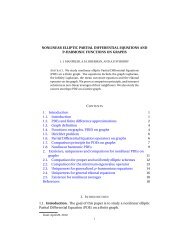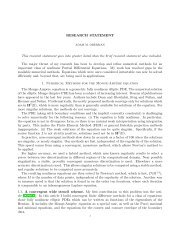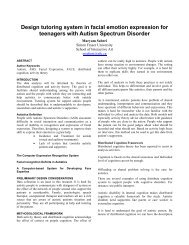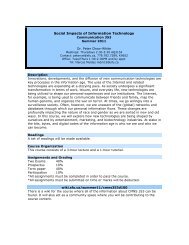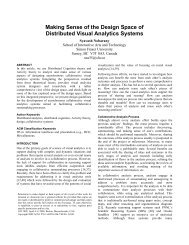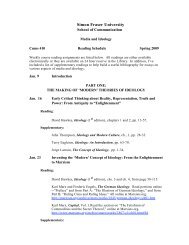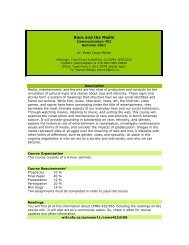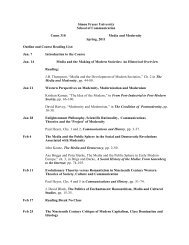IsoValue-0.18101-0.171727-0.162445-0.153162-0.14388-0.134597-0.125315-0.116032-0.106749-0.0974669-0.0881843-0.0789018-0.0696192-0.0603366-0.0510541-0.0417715-0.032489-0.0232064-0.0139238-0.00464128table:cone20 JEAN-DAVID BENAMOU, BRITTANY D. FROESE, AND ADAM M. OBERMANN∥ ∥ u − u(N) ∞(M1) (M1 ∗ )21 1.4 × 10 −2 2.5 × 10 −341 8.2 × 10 −3 1.5 × 10 −361 5.9 × 10 −3 1.1 × 10 −381 4.6 × 10 −3 8.4 × 10 −4101 3.8 × 10 −3 7.0 × 10 −4121 3.2 × 10 −3 6.0 × 10 −4141 2.8 × 10 −3 5.3 × 10 −4Table 13. Errors for the exact solution u(x, y) = √ x 2 + y 2 on anN × N grid.We monitor the difference between two succesive iterates, called convergencebelow, to check that the iterative process converges. Finally, we monitor the residualdefined as√R[u] = ∆T [u] − u 2 xx + u 2 yy + 2u 2 xy + 2f,which should go to 0 as we reach the solution of <strong>Monge</strong>-Ampère.In most examples, this finite element implementation is not significantly fasterthan the finite difference implementation. The adaptivity improved performance forthe example of §5.3. This method, initialised on a uniform 40×40 mesh, converges inabout 40 iterations whereas the finite difference implementation requires thousandsof iterations to converge. See Figure 11 and Table 8.(a)fig:nonsmooth_sol(b)fig:nonsmooth_convFigure 11. Results with f = 1 and homogeneous Dirichlet boundaryconditions initialised on a uniform 40 × 40 mesh. (a) Finalmesh and level curves of the solution. (b) Convergence and residualagainst number of iterations.fig:nonsmooth8. ConclusionsTwo simple numerical methods (M1), (M2) were introduced for solving (MA).Computations were performed on a number of solutions whose regularity ranged
TWO NUMERICAL METHODS FOR THE ELLIPTIC MONGE-AMPÈRE EQUATION 21from smooth to strongly singular. Iteration counts and computation times weremeasured for both methods. Performance comparisons were made between the twomethods, and, as much as possible, between results available for existing methods.The first, (M1), is a simple explicit finite difference method. While it is secondorder accurate, it is not monotone, so there is no convergence proof available. However,the method appeared to converge for all the numerical examples computed.These examples ranged from very smooth to singular (not in H 2 (Ω), Lipschitzcontinuous). The discrete equation was solved by a simple iterative method, andthe number of iterations (for fixed problem size) was roughly independent of theregularity of solution.We concluded that method, which is simply the natural finite difference discretizationof the equation, is the simplest and best performing method currentlyavailable, for generic problems. Only in the most singular case studied did theprovably convergent method of [21] perform better. However, in this case, we introduceda simple modification of (M1) which improved accuracy by an order ofmagnitude, §7.1.The second method used an algebraic identity satisfied by (MA) to write the solutionof the equation in terms of the Laplacian of a function of the norm of the Hessianof the solution and the source term (2.3). This led to an iterative method (M2)which required successive solutions of a Poisson equation. This method is simple toimplement and demonstrably superior to the other methods which required solutionsto be in H 2 (Ω). While the method of Dean and Glowinksi failed to convergefor a particular solution not in H 2 (Ω), (M2) converged for this example (althoughthe accuracy was less than for the smoother examples). Comparing the convergentexamples, the number of iterations to converge was about the same for both methods,but each iteration of (M2) is simpler because it involves only the solution of aPoisson equation.Compared to Method (M1), Method (M2) was faster (by at least an order ofmagnitude) on smooth solutions. However, strongly singular solutions led to apoorly conditioned Poisson equation, and (M2) it was slower (by more than anorder of magnitude) than (M1) on the most singular solutions.So we conclude that Method (M2) is the method of choice for solutions whichare known to be in H 2 (Ω) or better, while Method (M1) is the method of choicefor generic problems.References[1] I. Bakelman. Convex analysis and nonlinear geometric elliptic equations. Springer-Verlag,1994.[2] Guy Barles and Panagiotis E. Souganidis. Convergence of approximation schemes for fullynonlinear second order equations. Asymptotic Anal., 4(3):271–283, 1991.[3] Klaus Böhmer. On finite element methods for fully nonlinear elliptic equations of secondorder. SIAM J. Numer. Anal., 46(3):1212–1249, 2008.[4] L. Caffarelli, L. Nirenberg, and J. Spruck. The Dirichlet problem for nonlinear second-orderelliptic equations. I. <strong>Monge</strong>-Ampère equation. Comm. Pure Appl. Math., 37(3):369–402, 1984.[5] Luis A. Caffarelli and Mario Milman, editors. <strong>Monge</strong> Ampère equation: applications to geometryand optimization, volume 226 of Contemporary Mathematics, Providence, RI, 1999.American Mathematical Society.[6] Michael G. Crandall, Hitoshi Ishii, and Pierre-Louis Lions. User’s guide to viscosity solutionsof second order partial differential equations. Bull. Amer. Math. Soc. (N.S.), 27(1):1–67,1992.



